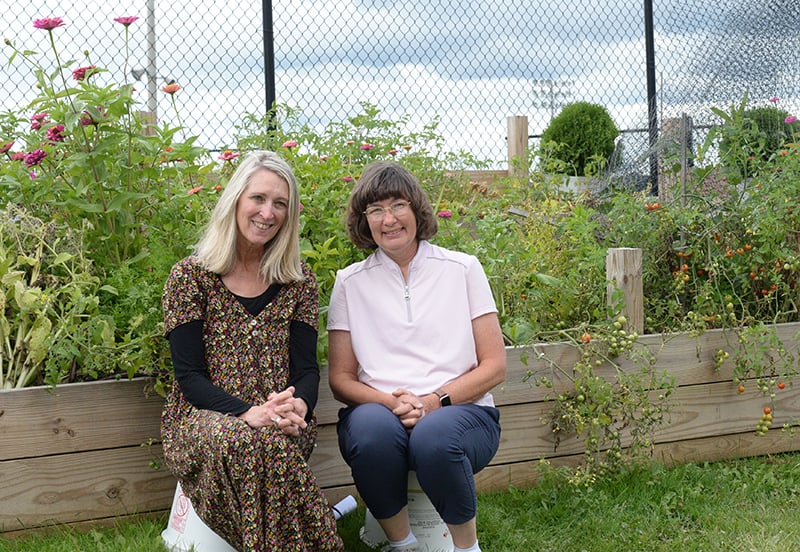330-476-6343 | [email protected]

330-476-6343 | [email protected]

By Carol McIntire
Editor
A Healthy Meals Incentive grant is opening doors for the food service program and students in Carrollton Schools.
Two staff members spearheading the program are running, not walking, through those doors and turning ideas into creative and educational opportunities for students. Their enthusiasm is contagious.
Barbara Burns, RDN, LD, the school district’s food service director, and Kay Russell, a veteran teacher who is beginning a new adventure as the district’s outdoor educator, are spearheading the program, which strives to enhance the nutritional quality of school meals.
To reach that goal, the district was awarded $146,588 in grant funds from Action for Healthy Kids. Burns wrote the grant and is administering the funds.
The two-year grant is part of an allocation of nearly $30 million by the U.S. Department of Agriculture’s Food and Nutrition Service to 264 schools across 44 states and the District of Columbia.
What’s most impressive about this program is the local project Burns proposed in her grant application. When Burns and Russell recently sat down together to talk about the program, the excitement and enthusiasm about their project was evident.
“We are going to expand our school garden and farm to school efforts, incorporate locally grown produce into school meals, get necessary training for staff and promote nutrition education by coordinating with our outdoor education program,” Burns said.
The project…. growing hydroponic lettuce that will used in school meals.
“Through the grant, we are purchasing two flex hydroponic grow panels and all necessary equipment. Each panel can produce 288 heads of lettuce every 30 days,” Burns explained. “Our hope is to provide 50 percent of the lettuce we use in the cafeteria on a yearly basis. Fresh lettuce will keep for two weeks in a cooler. Not only will be it a cost savings to the district, it will be an educational lesson for students.”
Cafeteria staff will receive training on proper food safety with freshly harvested food.
Russell’s eye lit up when she talked about the K-12 farm curriculum that meets state standards provided by the company that produces the grow panels.
“We are going to incorporate and expand our raised garden beds outside the POWER Center and the courtyard,” Russell explained. “Kids get first-hand experience here with growing food. We even have our own compost station.”
As part of the grant, new heavy-duty, weatherproof picnic tables will be purchased and utilized in the outdoor classroom setting.
The pair is teaming up with county health department, OSU Extension and Stark County Educational Service Center’s Farm to School coordinator to provide hands-on training and educational programs for students. They also plan to utilize the expertise of the district’s FFA and Family and Consumer Sciences staff as well.
“It’s like using the garden and cafeteria as a classroom,” Burns said, “and we’re strengthening our wellness policies. What we’re doing is high scale production of local food.”
“We are also going to resurrect the test kitchen and have students once again involved in the design of new cafeteria menu items,” Burns explained, recalling a program she initiated in the school in 2015 or 2016 when she became the food service coordinator.
She compared the test kitchen to the popular Iron Chef program where participants are provided a list of ingredients and guidelines and then prepare meals from it.
“We’ll have a Celebrity Panel of community members, like we did before, who come in and test the food. The kids and the panel both enjoyed that,” Burns noted.
Learning about food production in a hands-on manner is not new in the school district, according to Russell, who said this year’s fifth graders are reaping the rewards of their planting efforts while fourth graders last spring.
“They planted potatoes last spring before school was over,” Russell explained. “In a couple weeks the students, now fifth graders, will harvest the potatoes and enjoy a baked potato bar.”
Third grade students will replant the raised beds this fall and harvest the vegetables.
“They then get to enjoy vegetable soup,” Russell added.
Third and fourth grade students are learning about soil analysis. With the assistance of the Carroll Soil and Water Conservation District personnel, they will be part of soil testing along the entrance to the school where trees will be planted.
Fourth grade students are also learning about soil erosion.
All these lessons teach students about food production and the environment in a hands-on matter” according to Russell. Burns said it teaches students life skills.
“If they grow it, they know it!” she stated.
“The grants are the largest targeted investment USDA (United States Department of Agriculture) has ever made for school meal programs in small and rural communities,” said Stacy Dean, USDA deputy secretary for Food, Nutrition and Consumer Sciences. “We want to ensure every child in America has the opportunity to attend a school with high-quality, nutritious meals and this support is a big step in that direction.”
“When we strengthen school meal quality, we strengthen child health,” said Burns. “Research repeatedly shows that school meals are the healthiest meals in a day for most kids.”
Both women are excited to begin the process of providing locally grown food in the cafeteria and educating students.
“Every penny of this grant will be spent to improve the cafeteria and the district’s outdoor education program,” Burns said, adding,” that’s exciting!”
Interested in a monthl roundup of stories? Enter your email to be added to our mailing list.
